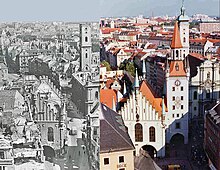
The bombing of Munich (Luftangriffe auf München) took place mainly in the later stages of World War II. Munich was, and is, a significant German city, as much culturally as industrially. Augsburg, thirty-seven miles to the west, was a main centre of diesel engine production (and still is today), and was also heavily bombed during the war. Although some considerable distance from the United Kingdom, Munich is not a difficult city to find from the air, mainly due to its size, and possibly its proximity to the Austrian Alps to the south-east as a visual reference point. Munich was protected (initially) by its distance from the United Kingdom. After a small air raid in November 1940[1] the city got little attention from bombers until 1944.
Munich was bombed by RAF Bomber Command and the United States Army Air Forces. There were seventy-four air raids on Munich, with 6,632 people killed and 15,800 wounded.[2] Around 90% of the Altstadt (old city) was severely damaged due to the policy of carpet bombing (Flächenbombardement). Munich was considered a special target of allied bombings also for propaganda purposes, in that it was the "movement's capital city", the Nazi Party's birthplace. At the start of the Großdeutsches Reich in 1939, Munich had a population of around 830,000, and was the fourth-largest city in Germany.
- ^ "RAF bombs Munich, Germany... Hitler escapes... - RareNewspapers.com". www.rarenewspapers.com. Retrieved 2023-06-14.
- ^ Bauer, Richard (1987). Fliegeralarm – Luftangriffe auf München von 1940 bis 1945. Munich: Hugendubel.